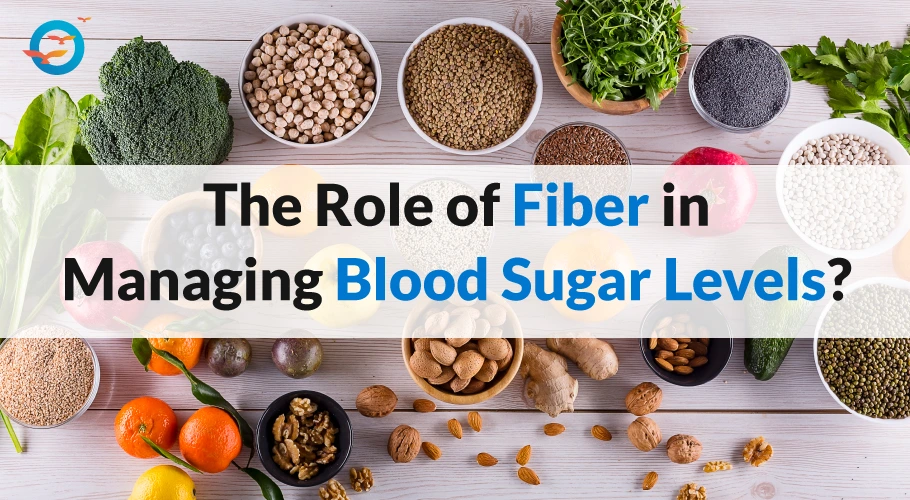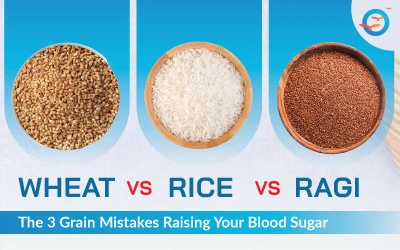The Role of Fiber in Managing Blood Sugar Levels?

How Fiber Helps Control Blood Sugar Naturally?
Blood sugar, or glucose, is the body’s main energy source, and keeping it stable is key to overall health especially for those with diabetes or pre-diabetes. While many factors affect blood sugar, diet plays a major role, and fiber is one of the most effective natural tools for managing it. This article explores how fiber helps maintain healthy blood sugar levels.
What Is Fiber?
Fiber is an indigestible type of carbohydrate found in plant-based foods. Unlike sugars and starches, it does not convert into glucose or raise blood sugar levels. Instead, it passes through the digestive system and supports gut health, improves digestion, and helps manage blood sugar.
What are the types of fiber and their role?
1. Soluble Fiber
Soluble fiber dissolves in water to form a gel-like substance in the digestive tract. This slows down the digestion process, which in turn helps regulate the absorption of sugars, preventing sharp spikes in blood sugar levels. It is particularly beneficial for people managing diabetes or looking to improve heart health.
Common sources: Oats, apples, beans, chia seeds.
2. Insoluble Fiber
Insoluble fiber does not dissolve in water. Instead, it adds bulk to the stool and promotes regular bowel movements, supporting overall digestive health. While it doesn’t significantly impact blood sugar levels directly, it plays a crucial role in maintaining a healthy gut environment.
Common sources: Whole wheat, carrots, nuts, green beans.
Including both types of fiber in your diet ensures better blood sugar management and supports overall health and digestion.
How Fiber Helps Manage Blood Sugar?
Benefits of fiber for diabetics
1. Slows sugar absorption: Soluble fiber slows digestion, helping sugar enter the bloodstream gradually and preventing sharp spikes.
2. Prevents blood sugar swings: By steadying glucose absorption, fiber helps avoid sudden highs and lows in blood sugar.
3. Promotes fullness: Fiber keeps you full longer, curbing cravings and reducing overeating, which stabilizes blood sugar.
4. Aids weight loss & insulin sensitivity: Fiber supports healthy weight loss, which improves insulin function and blood sugar control.
Best High-Fiber Foods for Blood Sugar Control
- Oats
- Chia seeds
- Flaxseeds
- Lentils and beans
- Apples and pears (with skin)
- Broccoli
- Whole grains (like brown rice, quinoa)
- Nuts and seeds
How Much Fiber Do You Need?
General Daily Recommendations:
Women: About 25 grams of fiber per day
Men: About 30–38 grams per day
These values support healthy digestion, blood sugar control, and heart health.
Most people consume far less than recommended often only 10–15 grams per day, due to diets high in processed foods and low in fruits, vegetables, and whole grains.
Smart Tip:
- If you’re not used to eating much fiber, increase your intake slowly over a few days. This helps your digestive system adjust and prevents gas, bloating, or discomfort.
- Balance it out:
Gradually introduce more plant-based foods (vegetables, fruits, whole grains, legumes). Drink plenty of water to help fiber move smoothly through your system.
Easy Tips to Add More Fiber to Your Diet
- Choose whole fruits instead of juice.
- Add beans or lentils to your meals.
- Snack on nuts or roasted chana.
- Use whole grain roti or bread.
- Sprinkle chia/flaxseeds on smoothies or salads.
Are there any cautions or considerations in relation to consuming fiber?
Increasing fiber has great benefits, but remember to drink more water to prevent constipation. Add fiber gradually if your diet was low before to avoid bloating. If you have diabetes, monitor your blood sugar as fiber can affect how your body handles carbs and medication. This helps you enjoy fiber’s benefits comfortably.
Conclusion -
Fiber is a simple, powerful way to manage blood sugar naturally. Found in affordable plant-based foods, it slows sugar absorption, keeps you full, and supports metabolic health. Combined with exercise, hydration, and good sleep, fiber helps maintain stable blood sugar and overall wellness.
Get started now.
Start improving your blood sugar by adding one fiber-rich meal today like oats, lentils, or an apple with skin. Share your favorite high-fiber food in the comments! And remember, consult your healthcare provider before making major diet changes.
Read more about foods to avoid diabetics, visit our blog.
FAQs
How does fiber help control blood sugar levels?
Fiber slows down digestion and sugar absorption, helping prevent spikes in blood sugar.
What type of fiber is best for managing blood sugar?
Soluble fiber is best—it forms a gel in the gut, slowing sugar release into the bloodstream.
Which high-fiber foods are good for diabetics?
Oats, chia seeds, lentils, apples (with skin), and broccoli are excellent choices.
Can eating more fiber lower my risk of type 2 diabetes?
Yes, a fiber-rich diet improves insulin sensitivity and helps prevent type 2 diabetes.
How much fiber should I eat daily to manage blood sugar?
Women need about 25g daily, men around 30–38g, ideally from whole plant foods.
Does fiber reduce sugar cravings or hunger?
Yes, fiber keeps you full longer, helping reduce cravings and overeating.
When is the best time to eat fiber for blood sugar control?
Include fiber with every meal to slow sugar absorption and stabilize blood sugar.

